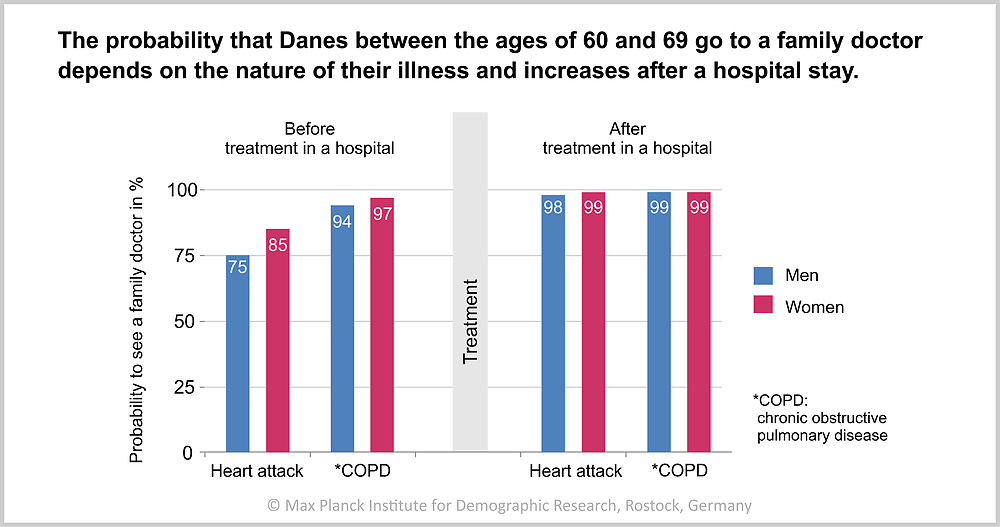May 01, 2020 | Press Release
More Similar than Expected: Men and Women Adjust their Health Behavior after Shock Events

After a hospital stay for the same illness, men and women begin to have a similar number of contacts with the doctor. © iStockphoto.com/KatarzynaBialasiewicz
Men go to the doctor less often than women. However, after experiencing a stay in hospital, the behavior of men and women becomes more similar. For the first time, MPIDR researchers have identified this pattern by evaluating more than 65,000 data records from Danish health registries.
In the three years before going to hospital for a stroke, heart attack or gastrointestinal cancers, only 75 percent of male patients in Denmark had seen a family doctor. In comparison, around 85 percent of female patients in Denmark had seen a family doctor. Following a heart attack 98 percent of male patients and 99 percent of female patients between the ages of 60 and 69, had contact with a family doctor in Denmark. This shows that gender differences in health behaviors level off after a stay in hospital.
In order to assess these important changes in gendered health behaviors Andreas Höhn, Jutta Gampe, and Anna Oksuzyan from the MPIDR, evaluated over 65,000 anonymized patient records from Danish registries. The data covered the time period between 1996 and 2011 and detailed the number of visits to the doctor in the three year period before and after a stay in hospital for the following diseases: stroke, heart attack, gastrointestinal cancers, and chronic obstructive pulmonary disease. The results were published in the Journal of Epidemiology and Community Health.

The researchers analysed data from Danish health registers to find out whether men and women, with the same disease, have different health behaviors. © MPIDR
“For the first time, we have investigated in great detail, and with a data set for a whole population, how men and women with the same disease behave,” says Andreas Höhn, who now works at the University of Edinburgh. The researchers also identified men and women who did not go to the doctor – because it was precisely these people who were not captured in the data used in similar studies in the past. “Our analyzes indicate that it is not easy for some women to go to the doctor, even when symptoms of a serious illness are likely. However, the percentage of men who do not go to a doctor is significantly higher than the percentage of women who do not go to the doctor,” says Andreas Höhn.
There is one exception: the behavior of men and women with chronic obstructive pulmonary disease. Regardless of gender, these patients frequently attended the family doctor even before a stay in hospital. Among those who were treated in hospital for chronic obstructive pulmonary disease, 94 percent of men and 97 percent of women had seen a family doctor before staying in hospital. These patients are more likely to have suffered from clear symptoms before requiring a stay in hospital.
After a stay in hospital, there were still small gender differences in the number of visits to the family doctor. The researchers think this is because men and women have different survival rates following a stay in hospital. “Even if men and women exhibit exactly the same behavior and have the same disease, more women will survive,” says Andreas Höhn. Many women would then see a doctor more often due to the ongoing health issues that resulted from the disease.
Original Publication
Höhn A, Gampe J, Lindahl-Jacobsen R, Christensen, K., Oksuzyan, A.: Do men avoid seeking medical advice? A register-based analysis of gender-specific changes in primary healthcare use after first hospitalisation at ages 60+ in Denmark. Journal of Epidemiology and Community Health (2020). DOI: 10.1136/jech-2019-213435